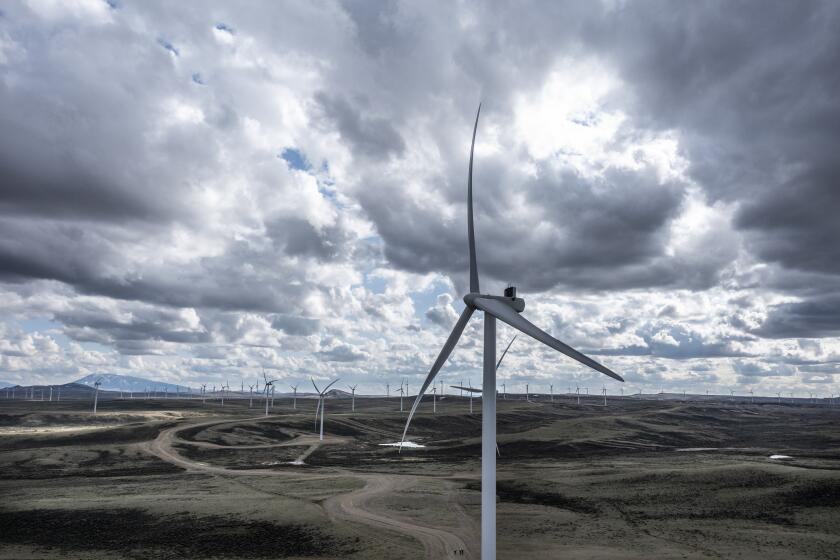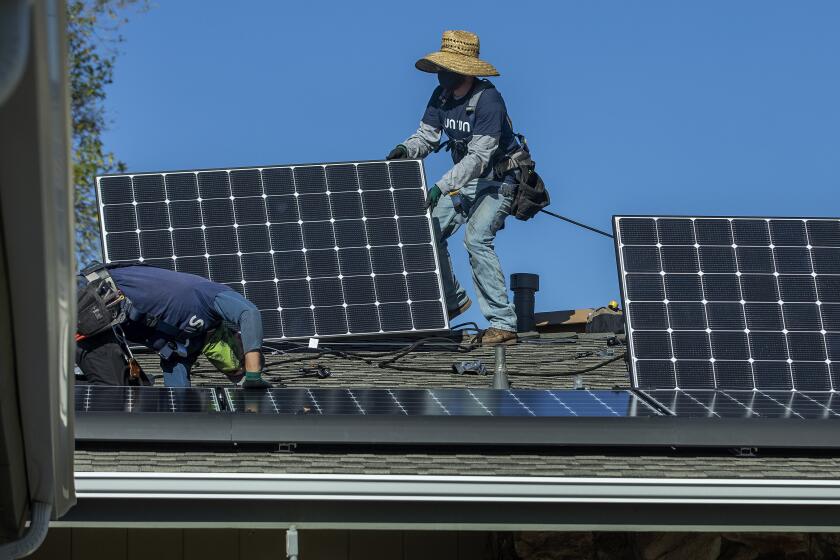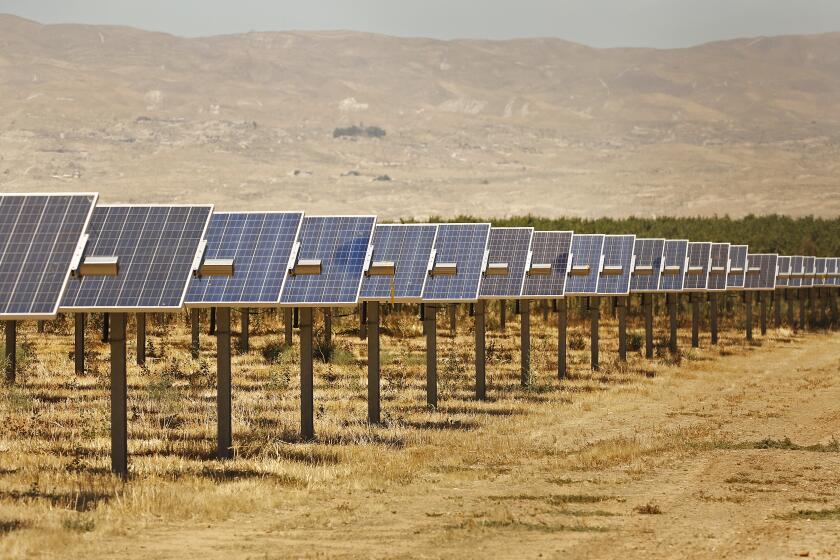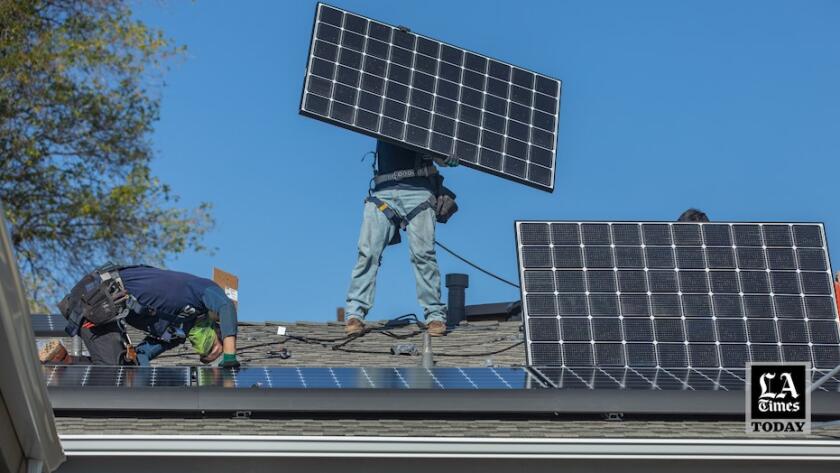California pushes a new plan to cut rooftop solar incentives
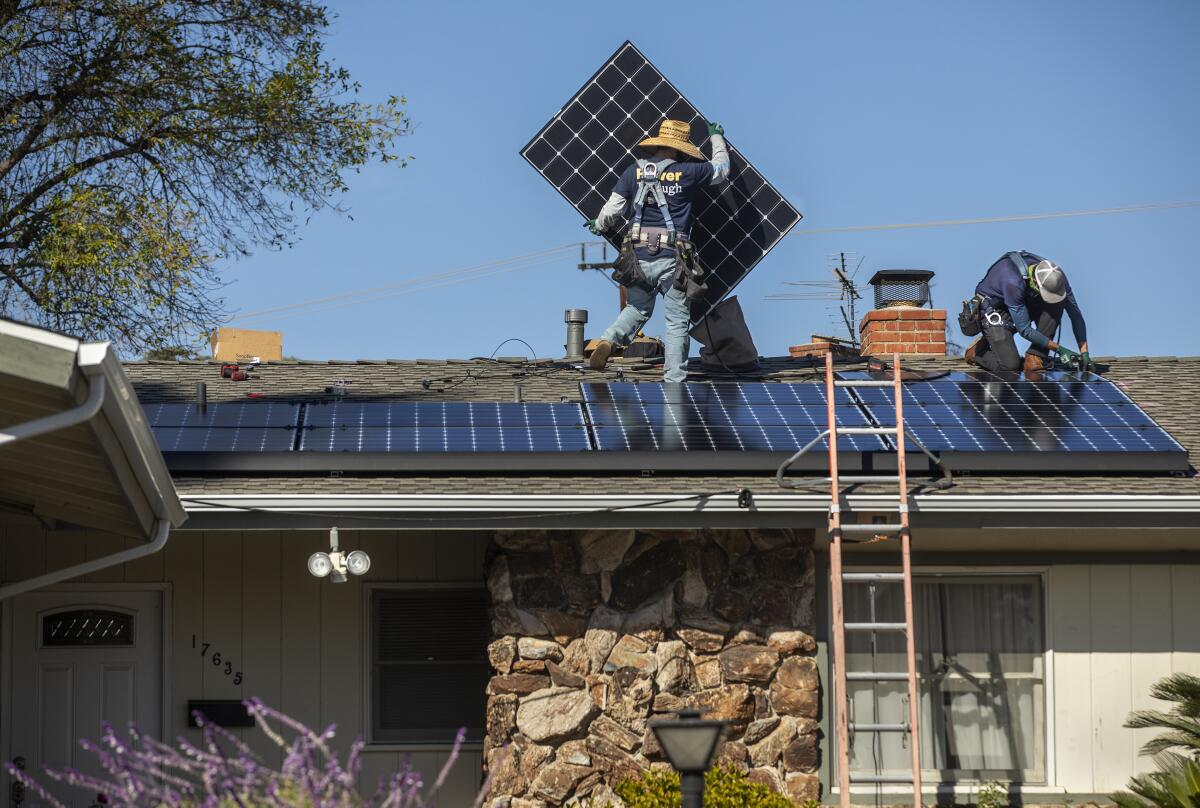
- Share via
California is poised to reduce payments to homes and businesses that go solar for clean electricity they supply to the power grid — a landmark shift in how the state promotes a crucial technology for fighting climate change.
The Public Utilities Commission’s proposal would keep the payment rates higher — at least for a few years — than a previous plan that faced sharp criticism from the solar industry and climate activists.
But it could still have dramatic ripple effects in the burgeoning rooftop solar market as the Golden State struggles to phase out planet-warming fossil fuels while avoiding blackouts and keeping electricity bills from spiraling out of control.
And it’s sure to spark a bitter fight in Sacramento, as rooftop solar installers, monopoly utility companies and labor unions whose members build large-scale solar farms duke it out over the best way for California to confront the climate crisis.
Already, the new plan is generating criticism from both the solar industry and a group backed by Southern California Edison and other utilities. The utilities say low-income households are being forced to subsidize wealthier solar customers.
The California Solar & Storage Assn. estimated that new solar customers would be paid a base rate of 5 cents per kilowatt-hour of electricity that they don’t use at home, sending it to the larger power grid — down from as much as 30 cents now.
Your guide to our clean energy future
Get our Boiling Point newsletter for the latest on the power sector, water wars and more — and what they mean for California.
You may occasionally receive promotional content from the Los Angeles Times.
Bernadette Del Chiaro, the trade group’s executive director, said in an email that the new plan “would protect utility monopolies and boost their profits, while making solar less affordable and delaying the goal of 100% clean energy.”
“California needs more solar power and more solar-charged batteries, not less,” she said.
But in a change likely to benefit the rooftop solar industry, new solar customers wouldn’t have to pay an $8-per-kilowatt monthly fee that was part of the previous proposal — a charge that would have amounted to $48 per month, or $576 per year, for a home with a six-kilowatt system.
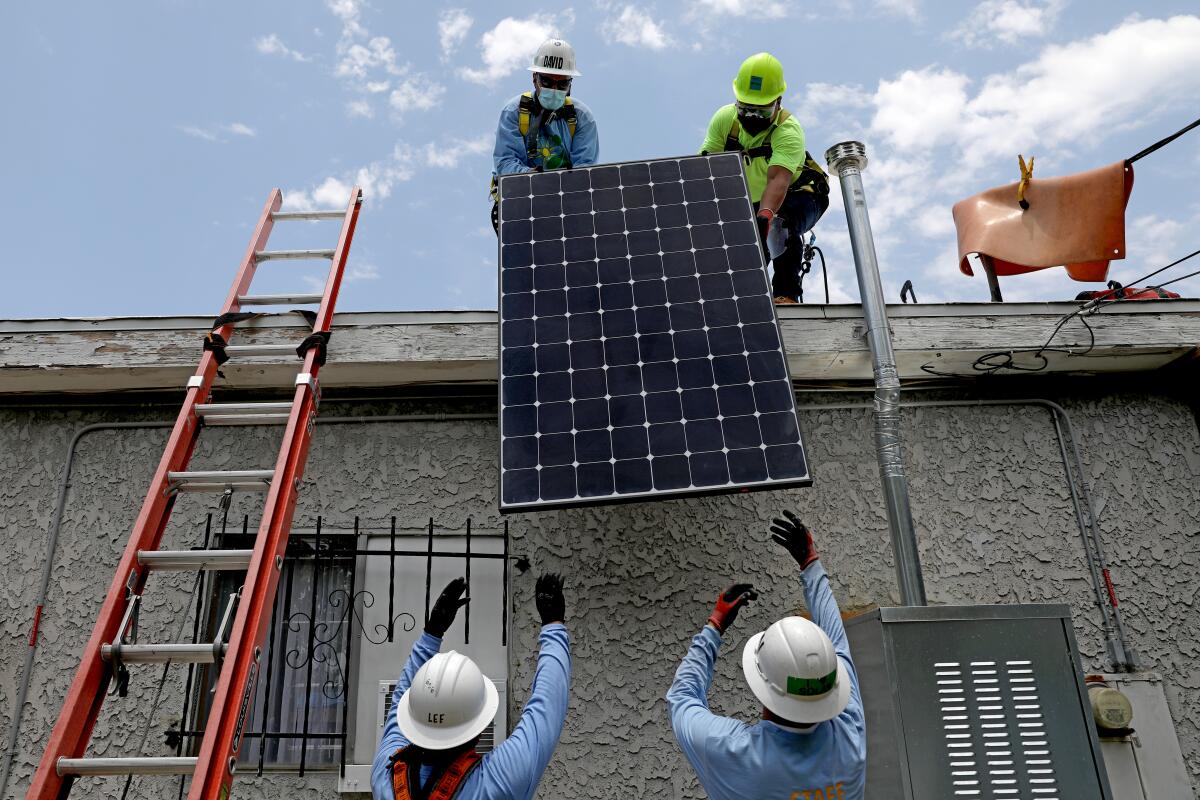
And for most solar homes, the reduced payment rates would be supplemented by additional incentives during the first decade of a rooftop system’s operation — higher incentives than contemplated under the previous proposal. That money would be available to households that go solar for the first five years after the decision is adopted, an increase from four years in the previous plan.
Homes that go solar earlier in the five-year window would lock in higher incentives.
Billionaire Phil Anschutz — who owns the Coachella music festival, the Los Angeles Kings hockey team and L.A.’s Crypto.com Arena — is preparing to build the nation’s largest wind farm. We traveled the route.
The state’s investor-owned utility companies — Edison, Pacific Gas & Electric and San Diego Gas & Electric, a Sempra Energy subsidiary — have pushed state officials to slash incentives for rooftop solar panels, which undercut their lucrative business model. And they weren’t happy with the changes proposed Thursday.
In a written statement, the Affordable Clean Energy for All campaign — which is funded by the three monopoly utilities — said the new proposal “fails to make the meaningful reform necessary to ensure that all electricity customers, those with rooftop solar and those without, pay their fair share of the costs” for maintaining the electric grid.
“It is extremely disappointing that under this proposal, low-income families and all customers without solar will continue to pay a hidden tax on their electricity bills to subsidize rooftop solar for mostly wealthier Californians,” said Kathy Fairbanks, a spokesperson for the utility-backed campaign.
“The failure to finally eliminate the growing cost burden carried by non-solar customers in California is particularly troublesome given the billions of dollars in new federal clean energy subsidies that will ensure continued growth and healthy profits for large solar corporations for the next decade,” she added.
The rooftop solar industry was similarly frustrated by the proposal.
Del Chiaro urged Gov. Gavin Newsom and his appointees on the utilities commission “to make further adjustments to help more middle- and working-class consumers as well as schools and farms access affordable, reliable, clean energy.”
“Better than ridiculously awful is hardly something to cheer,” she added via text, referring to the previous proposal.
Support our journalism
Your support helps us deliver the news that matters most. Subscribe to the Los Angeles Times.
Another trade group, the national Solar Energy Industries Assn., issued a disappointed but less fiery written statement.
The group’s president, Abigail Ross Hopper, applauded state officials for dropping the previously proposed monthly fee on solar customers but said that “additional work is needed to ensure a more gradual transition … so that all Californians, including schools, farms and low-income residents can adopt solar and storage.”
“Congress just passed the Inflation Reduction Act, which is the largest clean energy investment in our nation’s history,” she said. “Our progress now depends on states taking the baton and advancing policies to rapidly deploy clean energy and decarbonize the grid. California should be at the front of the pack.”
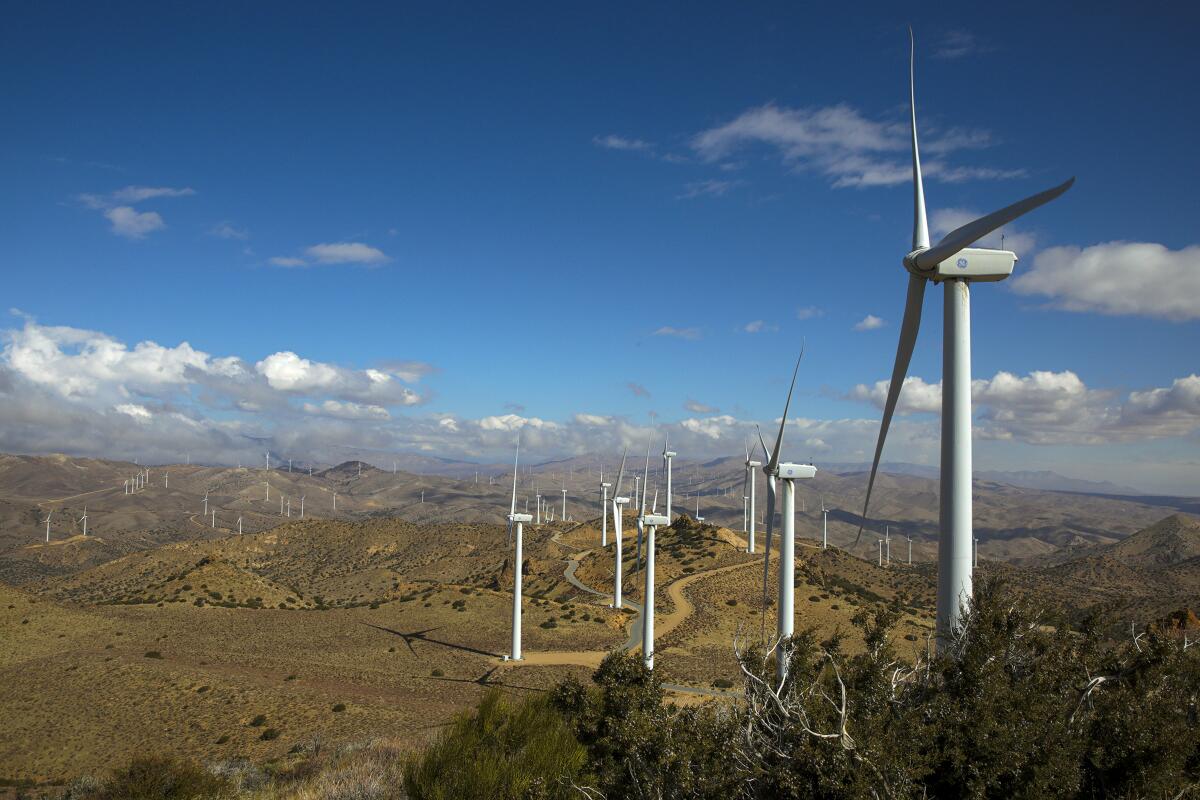
Homes and businesses that already have solar panels wouldn’t be affected by the changes to California’s “net metering” incentive program. Neither would utility customers who add solar panels within the first few months after the new rules are adopted.
The changes would affect only Edison, PG&E and SDG&E customers. Homes and businesses served by the Los Angeles Department of Water and Power and other city-run electric utilities would continue to have access to existing solar incentives.
David Hochschild — who leads another state agency, the California Energy Commission — described the proposal as a “haircut” for the rooftop solar industry. He said the plan is “vastly improved” from the previous version and would ensure that newly built homes — which are required to have solar panels — would still save money in the long run.
“That was very much in jeopardy with the last decision, and our team has looked at that and found that’s not an issue here,” Hochschild said in an interview.
A vote by the five-member utilities commission is expected as soon as next month.
If Joe Biden wants to help people save money, he could devote a big chunk of his climate efforts to solar and batteries.
California needs all the climate-friendly power it can get: Power plants fueled by natural gas generate more than one-third of the state’s electricity, even as solar and wind energy continue to grow. Gas plants are especially valuable on hot summer evenings — getting hotter as the planet heats up — when people come home from work and crank up their air conditioners, even as the sun goes down and solar panels stop generating. California has had trouble keeping the lights on some of those evenings.
Solar panels paired with batteries are one solution, enabling households to stay powered with clean electricity generated during the afternoon without straining the power grid. More than 1.5 million homes, businesses and other utility customers in California have gone solar. An increasing number are installing batteries too as prices begin to drop.
Last December’s proposal from the Public Utilities Commission was met with fury from climate activists and solar companies, who said the changes would undermine a successful renewable energy program and crash the solar industry. They pressured Newsom to lean on his appointees — which he did, prompting the utilities commission to reconsider its decision.
Several major environmental organizations weren’t fully satisfied by the changes unveiled Thursday.
The Center for Biological Diversity said in an emailed statement that the new plan “abandons the hefty solar tax from last year’s proposal but still threatens to put affordable renewable energy out of reach for most communities.” Environment California’s state director, Laura Deehan, criticized the proposal as “risky,” saying in an email that state officials “need to make rooftop solar as affordable and accessible as possible so that every household with solar potential can realistically make the choice to go solar.”
Republicans largely didn’t campaign against Biden’s clean energy bill. But Democrats may have missed an opportunity.
Sachu Constantine, executive director of advocacy group Vote Solar, thinks the utilities commission made the right move by eliminating new monthly fees. But he said the new proposal doesn’t do enough for low-income households. Although it would establish higher incentives for homes enrolled in low-income utility discount programs, that would cover only families below 200% of the federal poverty line, and miss millions of homes that might need help to afford solar panels and batteries.
“They are legitimately low- and middle-income families,” Constantine said in an interview.
Critics of current rooftop solar incentives — including ratepayer advocates and a handful of environmental groups — say the net metering program as it exists now could actually make it harder for the Golden State to fight climate change.
California’s climate ambitions require getting more people to drive electric vehicles, rather than gas-guzzling cars and trucks, and persuading them to replace their natural gas-burning furnaces and stoves with electric heat pumps and induction cooktops.

The more electricity rates rise, the more expensive it will be for Californians to invest in those technologies. And rates are rising, spurred in part by Edison, PG&E and SDG&E spending billions of dollars to stop their electric lines from sparking wildfires.
The cost of rooftop solar incentives is just one more factor driving up electric rates and making life harder for all but the wealthiest families, some experts say — and also making it harder for them to afford electric cars, heaters and stoves.
UC Berkeley energy economist Severin Borenstein said that the Public Utilities Commission’s new proposal wouldn’t do nearly enough to address the “cost shift” — the amount of money being transferred from non-solar households to their net-metered neighbors. The commission’s internal ratepayer watchdog estimates that cost shift will amount to $4.6 billion this year.
Even with new solar customers getting paid less for electricity they send to the grid, there would still be a “massive cost shift” during the first few years of the new program, as payment rates slowly decline to give the industry time to adjust.
“You look at the growth rate of rooftop solar right now, this isn’t even putting a Band-Aid on the bleeding. This is starting to walk to the cabinet to find a Band-Aid,” Borenstein said.
Borenstein thinks rooftop solar ought to be evaluated on a “level playing field” with other clean energy technologies, including large solar farms and wind turbines — both of which generate electricity at a lower cost due to economies of scale. Net metering, he believes, has given the rooftop solar industry an unfair leg up as California races toward 100% clean electricity by 2045.
Billionaire Phil Anschutz — who owns the Coachella music festival, the Los Angeles Kings hockey team and L.A.’s Crypto.com Arena — is preparing to build the nation’s largest wind farm. We traveled the route.
Within hours of the Public Utilities Commission releasing its new proposal, stock prices for leading rooftop solar installers surged. Sunrun Inc. shares closed 27% higher, while SunPower Corp. and Sunnova Energy International Inc. both rose nearly 20%.
Solar installers and many climate activists contend that the idea of a “cost shift” onto lower-income households is a farce. They say utility companies and state regulators have undercounted the savings that rooftop solar brings to all Californians by limiting the need for expensive new power plants and transmission lines — plus the health benefits of less pollution from burning fossil fuels, and the environmental benefits of not needing to pave over as much wildlife habitat to build large solar farms in the desert.
They also say the technology is not exclusively for the wealthy, even though solar customers are still mostly higher-income.
New data from Lawrence Berkeley National Laboratory show that 12% of California solar adopters in 2021 had incomes below $50,000, and that an additional 28% had incomes between $50,000 and $100,000 — up from 9% and 24%, respectively, in 2010.
There’s only so much land. Balancing clean energy and conservation will be crucial.
The Public Utilities Commission said in a written statement that its new proposal “continues to support the solar industry while it pivots to a solar plus battery storage marketplace, which will bolster the local green energy economy.”
The agency pointed to changes to electricity rate structures that it said would incentivize more Californians to pair their solar panels with batteries, and to operate their systems in a way that would support the larger power grid on the hottest summer days.

State officials also noted that low-income households would receive higher incentive payments for solar power that they send to the grid. And $900 million allocated by state lawmakers in this year’s budget will enable additional upfront incentive payments for solar panels paired with battery storage systems, with two-thirds of that money being set aside for low-income homes.
The commission will hold oral arguments on the new proposal next week.
State officials have had a difficult task in reevaluating rooftop solar incentives. State law requires the Public Utilities Commission to balance the costs and benefits of the net metering program, while also ensuring that rooftop solar installation “continues to grow sustainably.” The definition of “sustainable” growth has been a key sticking point in the debate.
In its new proposal, the commission said it was targeting a nine-year “payback period” — the amount of time it takes the average solar customer to make back their upfront investment through lower electric bills. Payback periods currently hover around five years. The utility companies had proposed incentive changes that could increase them to roughly 20 years.
For homes and businesses that install batteries along with solar, payback periods under the new program could be less than nine years. In its previous proposal, the commission had aimed for 10-year paybacks for Californians installing solar with storage.
In another change to its earlier plan, the agency says homes and businesses that already have solar would get to stay on their current incentive plans indefinitely. Previously, existing solar customers would have been switched to the lower incentive rates 15 years after their systems were installed, or 20 years for low-income homes.
- Share via
Watch L.A. Times Today at 7 p.m. on Spectrum News 1 on Channel 1 or live stream on the Spectrum News App. Palos Verdes Peninsula and Orange County viewers can watch on Cox Systems on channel 99.
More to Read
Inside the business of entertainment
The Wide Shot brings you news, analysis and insights on everything from streaming wars to production — and what it all means for the future.
You may occasionally receive promotional content from the Los Angeles Times.
